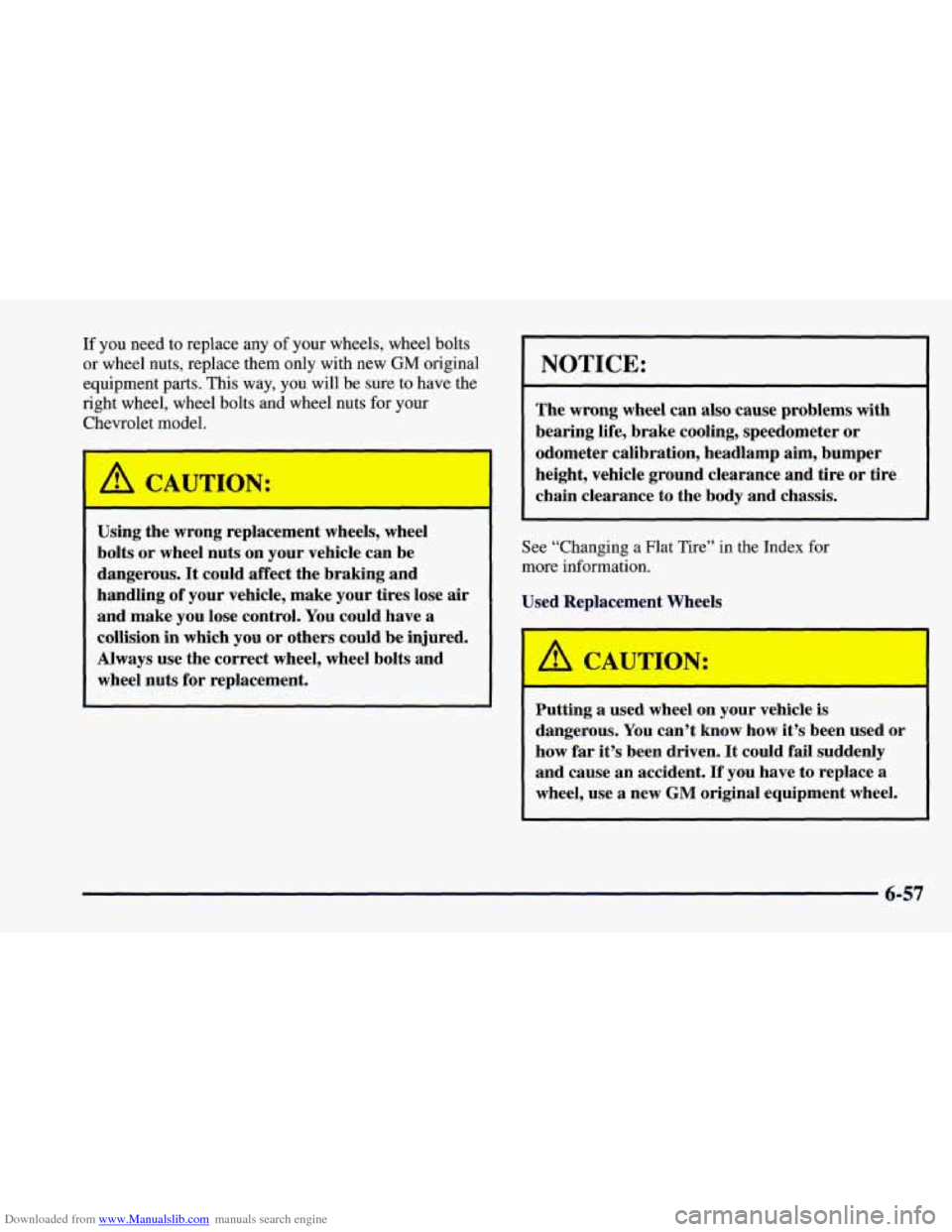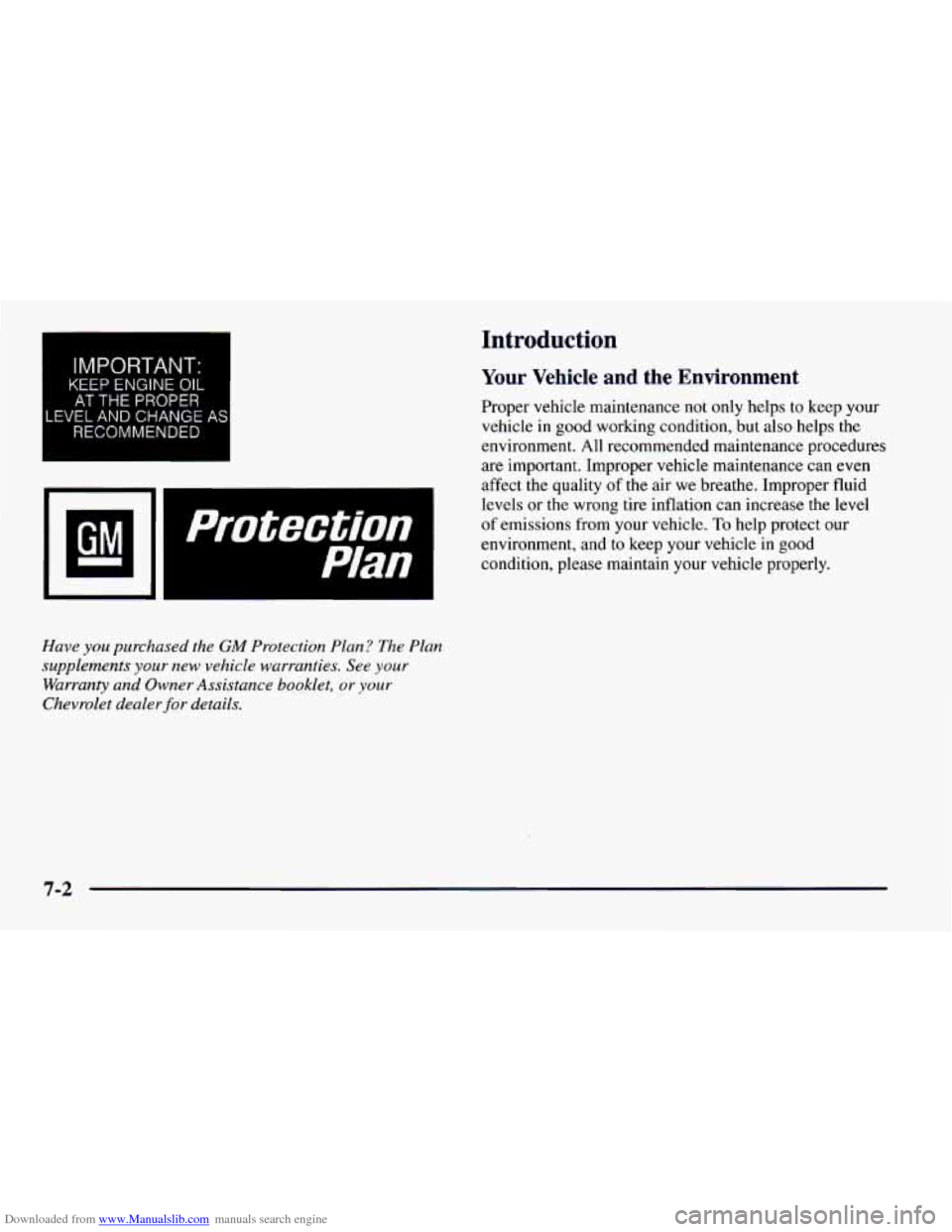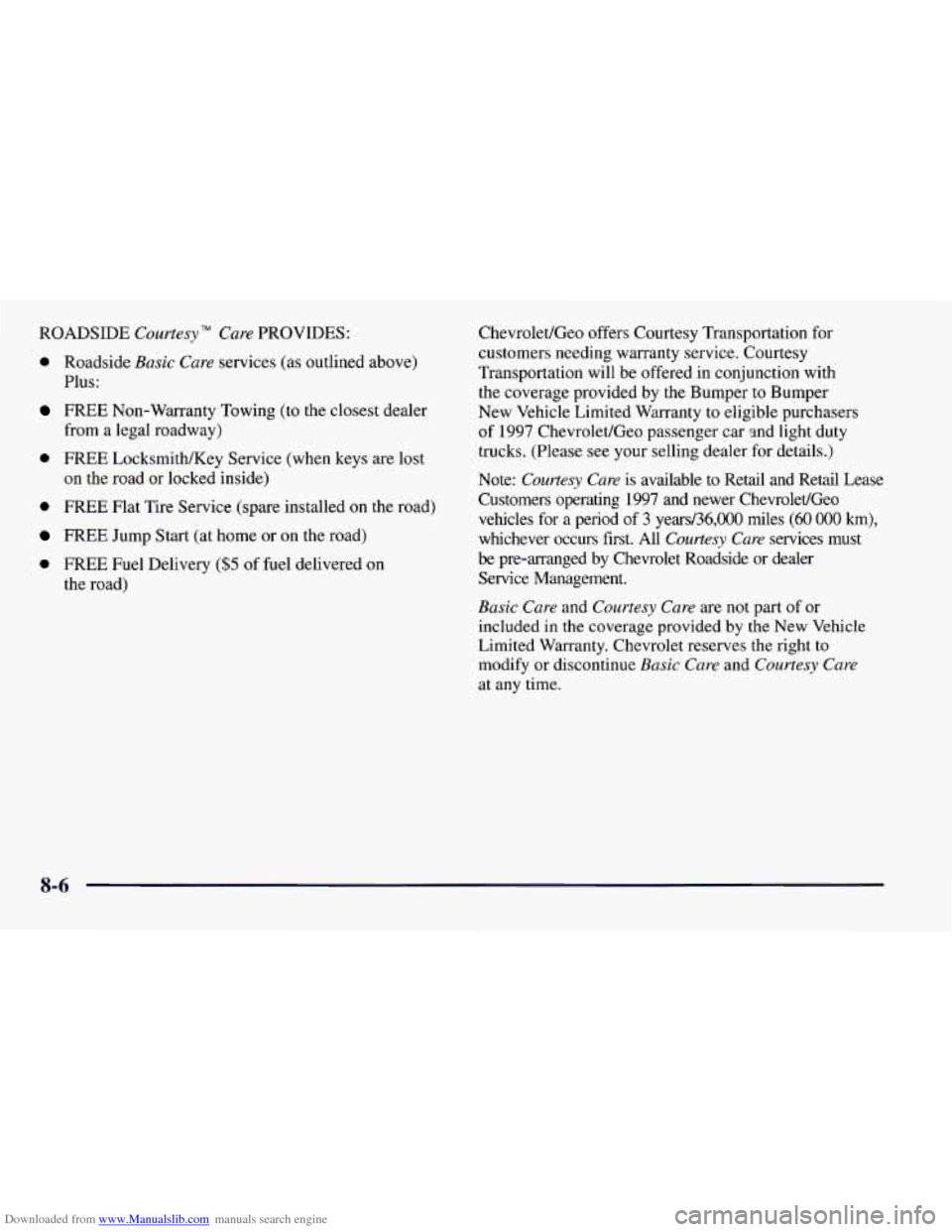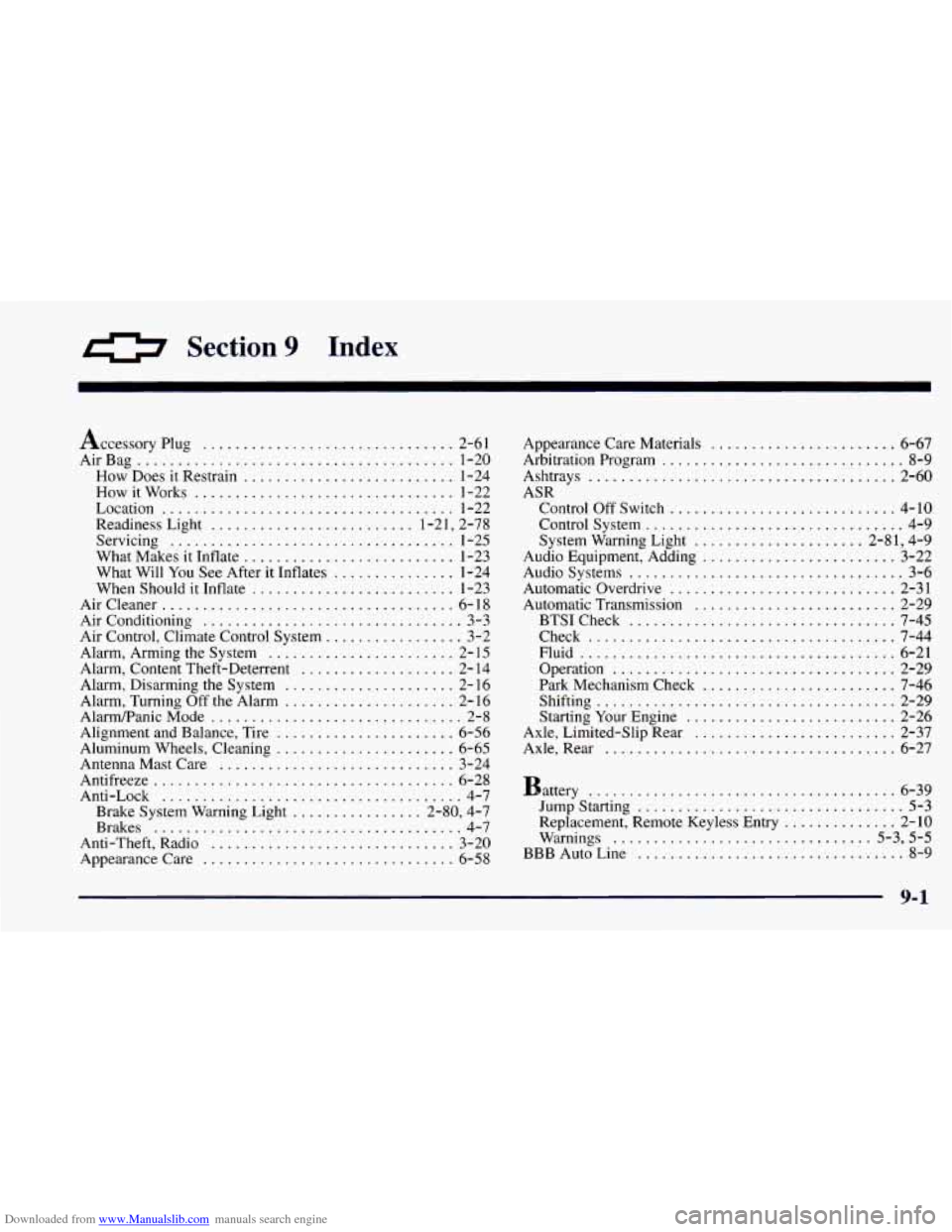1997 CHEVROLET CAMARO flat tire
[x] Cancel search: flat tirePage 298 of 404

Downloaded from www.Manualslib.com manuals search engine How to Check
Use a good quality pocket-type gage to check tire
pressure. You can’t tell if your tires are properly inflated
simply by looking at them. Radial tires may look
properly inflated even when they’re underinflated.
Be sure to put
the valve caps back on the valve stems.
They help prevent leaks by keeping out dirt and moisture.
Tire Inspection and Rotation
Tires should be rotated every 6,000 to 8,000 miles
(10
000 to 13 000 km). Any time you notice unusual
wear, rotate your tires as soon as possible and check
wheel alignment.
Also check for damaged tires or
wheels. See “When It’s Time for New Tires” and
“Wheel Replacement” later in this section for
more information.
The purpose of regular rotation is
to achieve more
uniform wear for all tires on the vehicle. The first
rotation is the most important. See “Scheduled
Maintenance Services” in the Index for scheduled
rotation intervals.
c-
If you don’t have P245/5OZR16 or P275/40ZR17
Goodyear Eagle GS-C tires, use the rotation pattern
shown above for your tires.
6-52
Page 299 of 404

Downloaded from www.Manualslib.com manuals search engine L
If you have P245/50ZR 16 or P275/40ZR17 Goodyear
Eagle GS-C tires, they must roll in a certain direction
for the best overall performance. The direction is shown
by an arrow
on the sidewall. Because these tires are
directional, they
should be rotated as shown here. These
tires should
only be moved from front to rear and rear to
front on the same side of the vehicle.
Don’t include the compact spare tire in your tire rotation. After the tires have been rotated,
adjust the front and
rear inflation pressures as shown
on the Tire-Loading
Information label. Make certain that all wheel
nuts are
properly tightened.
See “Wheel Nut Torque” in
the Index.
Rust or dirt on a wheel, or on the parts to which
it is fastened, can make wheel nuts become loose
after a time. The wheel could come
off and cause
an accident. When you change a wheel, remove
any rust or dirt from places where the wheel
attaches to the vehicle. In an emergency, you can
use a cloth or a paper towel to do this; but be
sure to use
a scraper or wire brush later, if you
need to, to get all
the rust or dirt off. (See
“Changing
a Flat Tire” in the Index.)
6-53
Page 302 of 404

Downloaded from www.Manualslib.com manuals search engine Traction -- A, B, C
The traction grades, from highest to lowest, are A, B,
and C, and they represent the tire’s ability to stop on
wet pavement as measured under controlled conditions
on specified government test surfaces of asphalt
and concrete. A tire marked C may have poor
traction performance.
Warning: The traction grade assigned to this tire is based
on braking (straightahead) traction tests and does not
include cornering (turning) traction.
Temper ’ ----, -- A, B, C
The temperature grades are A (the highest), B, and C,
representing the tire’s resistance to the generation of
heat and its ability to dissipate heat when tested under
controlled conditions on a specified indoor laboratory
test wheel. Sustained high temperature can cause the
material of the tire to degenerate and reduce tire life, and
excessive temperature can lead to sudden tire failure.
The grade
C corresponds to a level of performance
which all passenger car tires must meet under the
Federal Motor Vehicle Safety Standard
No. 109. Grades
B and A represent higher levels of performance on the
laboratory test wheel than the minimum required by law.
Warning: The temperature grade for this tire is
established for a tire that is properly inflated and not overloaded. Excessive speed,
underinflation,
or
excessive loading, either separately or in combination,
can cause heat buildup and possible tire failure.
Wheel Alignment and Tire Balance
The wheels on your vehicle were aligned and balanced
carefully at the factory to give you the longest tire life
and best overall performance.
Scheduled wheel alignment and wheel balancing are not
needed. However, if
you notice unusual tire wear or
your vehicle pulling one way
or the other, the alipnment
may need
to be reset. If you notice your vehicle
vibrating when driving on a smooth road, your wheels may need to be rebalanced.
Wheel Replacement
Replace any wheel that is bent, cracked, or badly rusted
or corroded.
If wheel nuts keep coming loose, the wheel,
wheel bolts and wheel nuts should be replaced. If the
wheel leaks air, replace it (except some aluminum
wheels, which can sometimes be repaired).
See your
Chevrolet dealer if any of these conditions exist.
Your dealer will know the kind of wheel you need.
Each new wheel should have the same load-carrying
capacity, diameter, width, offset and be mounted the
same way as the one it replaces.
6-56
Page 303 of 404

Downloaded from www.Manualslib.com manuals search engine If you need to replace any of your wheels, wheel bolts
or wheel nuts, replace them only with new
GM original
equipment parts. This way, you will be sure to have the
right wheel, wheel bolts and wheel nuts for your
Chevrolet model.
Using the wrong replacement wheels, wheel
bolts or wheel nuts on your vehicle can be
dangerous. It could affect the braking and
handling of your vehicle, make your tires lose
air
and make you lose control. You could have a
collision in which you or others could be injured.
Always use the correct wheel, wheel bolts and
wheel nuts for replacement.
NOTICE:
The wrong wheel can also cause problems with
bearing life, brake cooling, speedometer
or
odometer calibration, headlamp aim, bumper
height, vehicle ground clearance and tire or tire
chain clearance to the body and chassis.
See “Changing a Flat Tire” in the Index for
more information.
Used Replacement Wheels
Putting a used wheel on your vehicle
is
dangerous. You can’t know how it’s been used or
how
far it’s been driven. It could fail suddenly
and cause an accident.
If you have to replace a
wheel, use a new GM original equipment wheel.
6-57
Page 326 of 404

Downloaded from www.Manualslib.com manuals search engine LE
IMPORTANT:
KEEP ENGINE OIL
AT THE PROPER
!VEL AND CHANGE
RECOMMENDED
AS
Have you purchased the GM Protection Plan? The Plan
supplements your new vehicle warranties. See your
Warranty and Owner Assistance booklet, or your
Chevrolet dealer for details.
Introduction
Your Vehicle and the Environment
Proper vehicle maintenance not only helps to keep your
vehicle in good working condition, but also helps the
environment. All recommended maintenance procedures
are important. Improper vehicle maintenance can even
affect the quality
of the air we breathe. Improper fluid
levels or the wrong tire inflation can increase the level
of emissions from your vehicle. To help protect our
environment, and to keep your vehicle in good
condition, please maintain your vehicle properly.
7-2
Page 367 of 404

Downloaded from www.Manualslib.com manuals search engine Part B: Owner Checks and Services
Listed below are owner checks and services which
should be performed at the intervals specified to help
ensure the safety, dependability and emission control
performance
of your vehicle.
Be sure
any necessary repairs are completed at once.
Whenever any fluids or lubricants are added to your
vehicle, make sure they are the proper ones, as shown in
Part D.
At Each Fuel Fill
It is important for you or a service station attendant to
perform these underhood checks at each fuel fill.
Engine Oil Level Check
Check the engine oil level and add the proper oil if
necessary. See “Engine Oil’’ in the Index for
further details.
Engine Coolant Level Check
Check the engine coolant level and add DEX-COOL@
coolant mix if necessary. See “Engine Coolant” in the
Index for further details.
Windshield Washer Fluid Level Check
Check the windshield washer fluid level in the
windshield washer tank and add the proper fluid if
necessary. See “Windshield Washer Fluid” in the Index
for further details.
At Least Once a Month
Tire Inflation Check
Make sure tires are inflated to the correct pressures. See
“Tires” in the Index for further details.
Cassette Deck Service
Clean cassette deck. Cleaning should be done every
50 hours of tape play. See “Audio Systems” in the
Index for further details,
7-43
Page 382 of 404

Downloaded from www.Manualslib.com manuals search engine ROADSIDE Courtesy TM Care PROVIDES:
0 Roadside Basic Care services (as outlined above)
Plus
:
FREE Non-Warranty Towing (to the closest dealer
0 FREE LocksmitWKey Service (when keys are lost
0 FREE Flat Tire Service (spare installed on the road)
FREE Jump Start (at home or on the road)
0 FREE Fuel Delivery ($5 of fuel delivered on
from a legal roadway)
on the road or locked inside)
the road) Chevrolet/Geo offers Courtesy Transportation
for
customers needing warranty service. Courtesy
Transportation will be offered in conjunction with
the coverage provided by the Bumper
to Bumper
New Vehicle Limited Warranty
to eligible purchasers
of 1997 ChevroletlGeo passenger car 2nd light duty
trucks. (Please see your selling dealer for details.)
Note:
Courtesy Care is available to Retail and Retail Lease
Customers operating 1997 and newer Chevrolet/Geo
vehicles for
a period of 3 years/36,000 miles (60 000 km),
whichever occurs first. All Courtesy Care services must
be pre-arranged by Chevrolet Roadside or dealer
Service Management.
Basic Care and Courtesy Care are not part of or
included
in the coverage provided by the New Vehicle
Limited Warranty. Chevrolet reserves the right to
modify or discontinue Basic Care and Courtesy Care
at any time.
8-6
Page 391 of 404

Downloaded from www.Manualslib.com manuals search engine 0 Section 9 Index
Accessory Plug ............................... 2-61
AirBag
....................................... 1-20
How Does it Restrain
.......................... 1-24
How it Works
................................ 1-22
Location
.................................... 1-22
Readiness Light
......................... 1.21. 2.78
Servicing
................................... 1-25
What Makes
it Inflate .......................... 1-23
What Will You See After
it Inflates ............... 1-24
When Should
it Inflate ......................... 1-23
Aircleaner
.................................... 6-18
Air Conditioning
................................ 3-3
Air Control. Climate Control System
................. 3-2
Alarm. Arming the System
....................... 2- 15
Alarm. Content Theft-Deterrent
................... 2- 14
Alarm. Disarming
the System ..................... 2- 16
Alarm. Turning
Off the Alarm ..................... 2- 16
Alarm/PanicMode
............................... 2-8
Alignment and Balance. Tire
...................... 6-56
Aluminum Wheels. Cleaning ...................... 6-65
Antenna Mast Care
............................. 3-24
Antifreeze
..................................... 6-28
Anti-Lock
..................................... 4-7
Brake System Warning Light
................ 2-80. 4-7
Brakes
...................................... 4-7
Anti.Theft. Radio
.............................. 3-20
Appearancecare
............................... 6-58 Appearance Care Materials
....................... 6-67
Arbitration Program
.............................. 8-9
Ashtrays
...................................... 2-60
ASR Control Off Switch
............................ 4-10
Control System
................................ 4-9
System Warning Light
..................... 2-81. 4-9
Audio Equipment. Adding
........................ 3-22
Audio Systems
.................................. 3-6
Automatic Overdrive
............................ 2-31
Automatic Transmission
......................... 2-29
BTSICheck
................................. 7-45
Check
...................................... 7-44
Fluid
....................................... 6-21
Operation
................................... 2-29
Park Mechanism Check
........................ 7-46
Shifting
..................................... 2-29
Starting Your Engine
.......................... 2-26
Axle. Limited-Slip Rear
......................... 2-37
Axle. Rear
.................................... 6-27
Battery
...................................... 6-39
Jump Starting
................................. 5-3
Warnings ................................ 5-3. 5-5
BBB Auto Line ................................. 8-9
Replacement. Remote Keyless Entry .............. 2-10
9-1